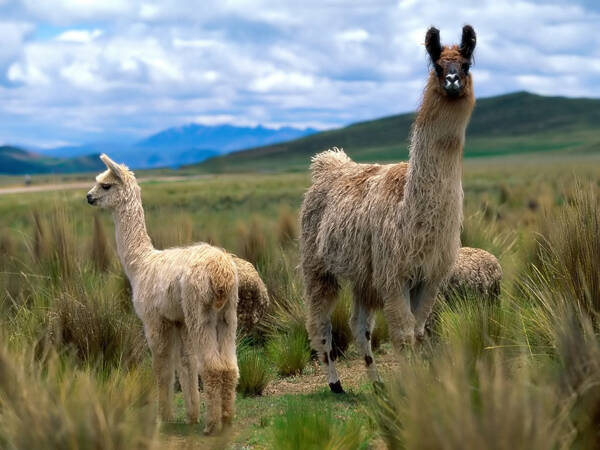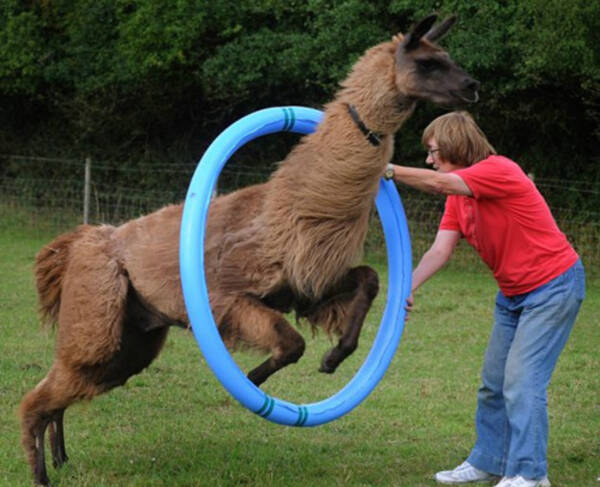Lama glama
IUCN
LCBasic Information
Scientific classification
- name:Lama glama
- Scientific Name:Lama glama,llama,Domestic Alpaca
- Outline:Ungulata
- Family:Artiodactyla Camelidae Alpaca
Vital signs
- length:1.6-1.8m
- Weight:127-204kg
- lifetime:About 20 years
Feature
Long limbs, protruding and curved ears
Distribution and Habitat
Alpacas are only native animals in South America, mainly distributed along the central and western parts of the American continent. In Peru, Chile, Bolivia and other countries, the Ticatacá area is particularly concentrated, and most of them live in the Andes Mountains on the border between Peru and Bolivia.
Appearance
The dentition of an adult llama is: 1/3 incisors, 1/1 canines, 2/2 premolars, 3/3 molars, for a total of 32 teeth. There is a sharp incisor in the upper jaw near the rear edge of the premaxilla, followed by a curved canine inside the jaw in males. Their premolars are not like canines in camels, but are very small. The molar row consists of 3 broad molars, which is somewhat like other camels. In the lower jaw, the three incisors are long and flat, with the outermost incisor being the smallest. Next are the curved and nearly vertical canines, and a small space and conical premolars that are replaced every year. There is another premolar in front of the three molars.
The skull of the llama is like that of the camelid, but the brain cavity and eye sockets are larger, and the vertebrae of the skull are smaller. The nasal bone is short and wide, and is connected to the premaxilla. Alpacas have 7 cervical vertebrae, 12 dorsal vertebrae, 7 lumbar vertebrae, 4 pelvic vertebrae and 15-20 caud
Details
The llama (Latin scientific name: Lama glama, English name: llama) is the heaviest and largest South American alpaca in South America.

Llamas are social animals and are trained to use nooses and lead the way after weaning. They are very friendly. They are extremely curious and happy to interact with humans. However, alpacas that have been artificially fed, excessively socialized or controlled when they are young will become difficult to control when they grow up. They will treat humans as other alpacas, spitting, kicking and necking them. Wrestling. Therefore, it is necessary to reduce or even stop artificial feeding of young alpacas.
If llamas are raised correctly, they will rarely spit. They are pack animals and will sometimes spit at each other to teach lower-ranking llamas a lesson. The social status of llamas is constantly changing. It may only take a small fight to achieve a high or low status. Their fighting methods include spitting, pushing each other with their chests, wrestling with their necks and kicking each other to knock each other down. Females generally control their group members only by spitting. Llamas have large upper teeth that are used for fighting and biting each other's testicles.
Although their social status changes, llamas still look out for each other. If one of them detects a strange noise or feels threatened, they sound an alarm to other members of the pack. They hum to each other as a way of communicating. A llama's grunt indicates fear or anger. When a llama is harassed, it will put its ears back. If a llama is severely irritated, it will spit out liquid from the back of its stomach.

The reproductive cycle of llamas is unique, as females undergo induced ovulation. During mating, the female ovulates and is usually fertilized immediately, so they do not have an estrous cycle. Male and female alpacas reach sexual maturity at different rates, just like humans. Females reach puberty at about 12 months of age, but males take about three years to reach sexual maturity. Male and female alpacas mate while lying down, which lasts about 20 to 45 minutes, which is rare among large animals. Male llamas make noises during mating. The sound is like gargling, but more powerful. The male will start making this sound when he climaxes and maintain it throughout the process, which lasts from about 15 minutes to more than an hour. The llama's gestation period is 11.5 months. Female llamas will not lick their young llamas because their tongues can only stick out of their mouths for about half an inch, so they will only nuzzle the young llamas.
Alpacas have a gentle temperament and will not poke people. They are always in a quiet state and will not try to escape, so they do not need fences. Alpacas like to live in groups and cannot survive independently. Alpacas only defecate in fixed locations on the farm, making it easy to collect and clean up. Alpaca manure is also a good source of fertilizer. Fixed defecation sites inhibit the spread of parasites. Alpacas do not eat excessively and always move steadily during the feeding process. When eating grass, they cut off and nibble a small portion of the tips of grasses or the tips of shrubs and grasses. Therefore, alpacas naturally do not destroy the pasture. Alpacas do not chew bark or eat whole trees, but they do eat leaves. Llamas produce enough alpaca fleece to make several sweatshirts each year. The llama's four hooves are flesh-clawed, so even if it walks through the grass after rain, it will not trample the turf. The alpaca is an improved ruminant. Although it eats less grass, it can convert it into energy very efficiently. As a member of the camelid family, alpacas also have less water needs. In addition, alpacas are also great caregiver animals, protecting other animals such as sheep from predators.
Fifteen years ago, llamas were only found in South America (mainly Peru, with 1.9 million head). Despite import controls, strict inspection and quarantine systems, and no support from artificial breeding programs, alpaca breeding has also experienced certain growth. Currently, alpaca breeding bases are firmly rooted in Australia, New Zealand, North America, and the United Kingdom, and there are flocks of them. Free-range farming is also taking off in Germany, Israel, France and Japan. The alpaca industry not only offers huge returns on investment, but also brings unlimited fun and satisfaction to practitioners. Therefore, the demand for alpaca products is increasing around the world, and investment momentum is getting stronger.
Protect wild animals and eliminate wild game.
Maintaining ecological balance is everyone’s responsibility!








